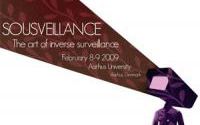|
 With the growing spread of pervasive digital technologies the public urban space has become open for new forms of both observation and surveillance. With the growing spread of pervasive digital technologies the public urban space has become open for new forms of both observation and surveillance.
Moving away from cameras and directional microphones, face- and voice recognition, the pervasive technologies offer not only the ability to gather and organise huge amounts of dissimilar data. Furthermore, this data can be used to to predict probable patterns of behaviour. Surveillance technology is used by states (to fight crime and terror), commercially (Google Maps, YouTube or Facebook). Digital art represents a reflection on the experience of surveillance technology and how it is embedded in our culture. Urban games, locative art, flashmob art, pervasive games etc. all represent new forms of observational and aesthetic experiments with how we, through technology, perceive and make use of the urban public space.
Digital Urban Living addresses this via an exhibition at Skive Art Museum: No Place To Hide and am academic conference featuring both lectures by researchers and artist talks.
Links
Exhibition: NO PLACE TO HIDE, Skive Ny Kunstmuseum, February 17-April 13
- Press release:
http://www.skivekunstmuseum.dk/data/images/SNYK_PRESSE_NoPlaceToHide.pdf
 Conference: SOUSVEILLANCE – THE ART OF INVERSE SURVEILLANCE Conference: SOUSVEILLANCE – THE ART OF INVERSE SURVEILLANCE
- Conference website: http://www.digitalurbanliving.dk/sousveillance/
- Features at DARC (Digital Aesthetics Research Center): http://darc.imv.au.dk/?tag=sousveillance-the-art-of-inverse-surveillance
 - Newsletter from TEKNE: http://www.teknenet.dk/tekne_nyhedsbrev/nyhedsbr_9_09.htm#sousveillance - Newsletter from TEKNE: http://www.teknenet.dk/tekne_nyhedsbrev/nyhedsbr_9_09.htm#sousveillance
|


 With the growing spread of pervasive digital technologies the public urban space has become open for new forms of both observation and surveillance.
With the growing spread of pervasive digital technologies the public urban space has become open for new forms of both observation and surveillance.

